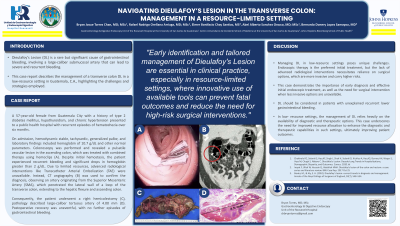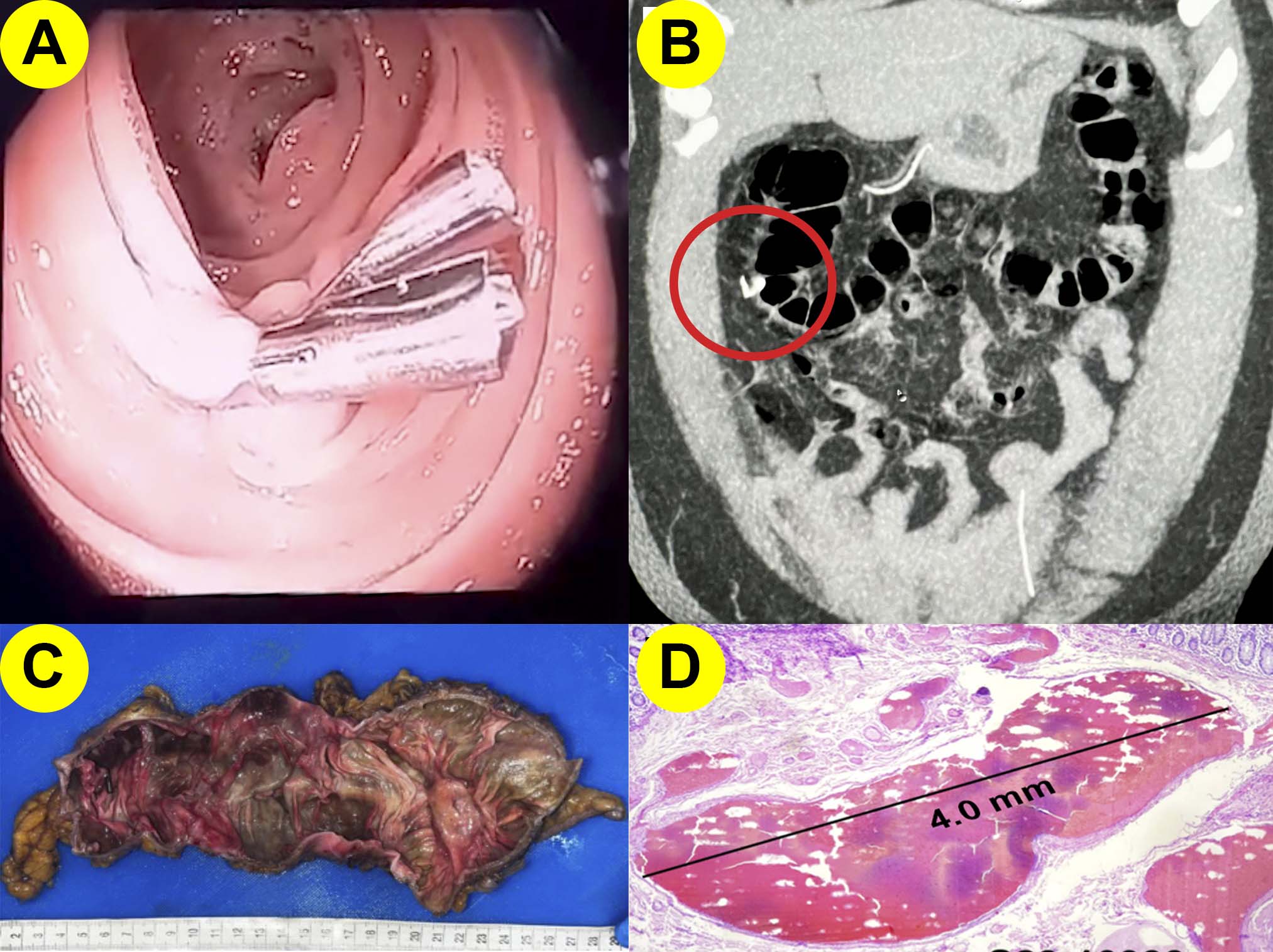Sunday Poster Session
Category: GI Bleeding
P0765 - Navigating Dieulafoy’s Lesion in the Transverse Colon: Management in a Resource-Limited Setting
Sunday, October 27, 2024
3:30 PM - 7:00 PM ET
Location: Exhibit Hall E

Has Audio

Abel Alberto Sanchez Orozco, MD, MSc
Gastroenterology & Digestive Endoscopy Unit of the Roosevelt Hospital at the University of San Carlos de Guatemala
Guatemala City, San Marcos, Guatemala
Presenting Author(s)
Bryan Josue Torres Chan, MD, MSc1, Rafael Rodrigo Orellana Arriaga, MD, MSc2, Elmer Bonifacio Chay Santizo, MS3, Abel Alberto Sanchez Orozco, MD, MSc4, Bernardo Donery Lopez Samayoa, MD5
1Gastroenterology & Digestive Endoscopy Unit of the Roosevelt Hospital at the University of San Carlos de Guatemala, Guatemala, Chimaltenango, Guatemala; 2Gastroenterology & Digestive Endoscopy Unit of the Roosevelt Hospital at the University of San Carlos de Guatemala, Santa Tecla, La Libertad, El Salvador; 3Centro Universitario de Occidente School of Medicine at the University of San Carlos de Guatemala, Quetzaltenango, Quetzaltenango, Guatemala; 4Gastroenterology & Digestive Endoscopy Unit of the Roosevelt Hospital at the University of San Carlos de Guatemala, Guatemala City, San Marcos, Guatemala; 5Johns Hopkins Bloomberg School of Public Health, Baltimore, MD
Introduction: Dieulafoy’s Lesion (DL) is a rare but significant cause of gastrointestinal bleeding, involving a large-caliber submucosal artery that can lead to severe and recurrent bleeding. This case report describes the management of a transverse colon DL in a low-resource setting in Guatemala, C.A., highlighting the challenges and strategies employed.
Case Description/Methods: A 57-year-old female from Guatemala City with a history of type 2 diabetes mellitus, hypothyroidism, and chronic hypertension presented to a public health hospital with recurrent episodes of hematochezia over six months. On admission, hemodynamic stable, tachycardic, generalized pallor, and laboratory findings included hemoglobin of 10.7 g/dL and other normal parameters. Colonoscopy was performed and revealed a pulsatile vascular lesion in the ascending colon, which was treated with combined therapy using hemoclips (A). Despite initial hemostasis, the patient experienced recurrent bleeding and significant drops in hemoglobin greater than 2 g/dL. Due to limited resources, advanced radiological interventions like Transcatheter Arterial Embolization (TAE) were unavailable. Instead, CT angiography (B) was used to confirm the diagnosis, observing an artery originating from the Superior Mesenteric Artery (SMA), which penetrated the lateral wall of a loop of the transverse colon, extending to the hepatic flexure and ascending colon. Consequently, the patient underwent a right hemicolectomy (C), pathology described large-caliber tortuous artery of 4.00 mm (D). Postoperative recovery was uneventful, with no further episodes of gastrointestinal bleeding.
Discussion: Managing DL in low-resource settings poses unique challenges. Endoscopic therapy is the preferred initial treatment, but the lack of advanced radiological interventions necessitates reliance on surgical options, which are more invasive and carry higher risks. This case demonstrates the importance of early diagnosis and effective initial endoscopic treatment, as well as the need for surgical intervention when less invasive options are unavailable.
DL should be considered in patients with unexplained recurrent lower gastrointestinal bleeding. In low-resource settings, the management of DL relies heavily on the availability of diagnostic and therapeutic options. This case underscores the need for improved resource allocation to enhance the diagnostic and therapeutic capabilities in such settings, ultimately improving patient outcomes.

Disclosures:
Bryan Josue Torres Chan, MD, MSc1, Rafael Rodrigo Orellana Arriaga, MD, MSc2, Elmer Bonifacio Chay Santizo, MS3, Abel Alberto Sanchez Orozco, MD, MSc4, Bernardo Donery Lopez Samayoa, MD5. P0765 - Navigating Dieulafoy’s Lesion in the Transverse Colon: Management in a Resource-Limited Setting, ACG 2024 Annual Scientific Meeting Abstracts. Philadelphia, PA: American College of Gastroenterology.
1Gastroenterology & Digestive Endoscopy Unit of the Roosevelt Hospital at the University of San Carlos de Guatemala, Guatemala, Chimaltenango, Guatemala; 2Gastroenterology & Digestive Endoscopy Unit of the Roosevelt Hospital at the University of San Carlos de Guatemala, Santa Tecla, La Libertad, El Salvador; 3Centro Universitario de Occidente School of Medicine at the University of San Carlos de Guatemala, Quetzaltenango, Quetzaltenango, Guatemala; 4Gastroenterology & Digestive Endoscopy Unit of the Roosevelt Hospital at the University of San Carlos de Guatemala, Guatemala City, San Marcos, Guatemala; 5Johns Hopkins Bloomberg School of Public Health, Baltimore, MD
Introduction: Dieulafoy’s Lesion (DL) is a rare but significant cause of gastrointestinal bleeding, involving a large-caliber submucosal artery that can lead to severe and recurrent bleeding. This case report describes the management of a transverse colon DL in a low-resource setting in Guatemala, C.A., highlighting the challenges and strategies employed.
Case Description/Methods: A 57-year-old female from Guatemala City with a history of type 2 diabetes mellitus, hypothyroidism, and chronic hypertension presented to a public health hospital with recurrent episodes of hematochezia over six months. On admission, hemodynamic stable, tachycardic, generalized pallor, and laboratory findings included hemoglobin of 10.7 g/dL and other normal parameters. Colonoscopy was performed and revealed a pulsatile vascular lesion in the ascending colon, which was treated with combined therapy using hemoclips (A). Despite initial hemostasis, the patient experienced recurrent bleeding and significant drops in hemoglobin greater than 2 g/dL. Due to limited resources, advanced radiological interventions like Transcatheter Arterial Embolization (TAE) were unavailable. Instead, CT angiography (B) was used to confirm the diagnosis, observing an artery originating from the Superior Mesenteric Artery (SMA), which penetrated the lateral wall of a loop of the transverse colon, extending to the hepatic flexure and ascending colon. Consequently, the patient underwent a right hemicolectomy (C), pathology described large-caliber tortuous artery of 4.00 mm (D). Postoperative recovery was uneventful, with no further episodes of gastrointestinal bleeding.
Discussion: Managing DL in low-resource settings poses unique challenges. Endoscopic therapy is the preferred initial treatment, but the lack of advanced radiological interventions necessitates reliance on surgical options, which are more invasive and carry higher risks. This case demonstrates the importance of early diagnosis and effective initial endoscopic treatment, as well as the need for surgical intervention when less invasive options are unavailable.
DL should be considered in patients with unexplained recurrent lower gastrointestinal bleeding. In low-resource settings, the management of DL relies heavily on the availability of diagnostic and therapeutic options. This case underscores the need for improved resource allocation to enhance the diagnostic and therapeutic capabilities in such settings, ultimately improving patient outcomes.

Figure: Dieulafoy's lesion (A) in the ascending colon visualized by colonoscopy, treated with 2 hemoclips. Sagittal CT angiogram (B) showing Dieulafoy's lesion originating from the Superior Mesenteric Artery. Surgical specimen including cecum, appendix, and ascending colon (C), measuring 22 x 7 x 5 cm, with hemoclip present. The serosa is smooth, grayish, with purplish areas and fine vasculature. Histological section of the colon (D) showing markedly dilated and tortuous arteries in the submucosa, the largest measuring 4 mm, indicating an arterial malformation.
Disclosures:
Bryan Josue Torres Chan indicated no relevant financial relationships.
Rafael Rodrigo Orellana Arriaga indicated no relevant financial relationships.
Elmer Bonifacio Chay Santizo indicated no relevant financial relationships.
Abel Alberto Sanchez Orozco indicated no relevant financial relationships.
Bernardo Donery Lopez Samayoa indicated no relevant financial relationships.
Bryan Josue Torres Chan, MD, MSc1, Rafael Rodrigo Orellana Arriaga, MD, MSc2, Elmer Bonifacio Chay Santizo, MS3, Abel Alberto Sanchez Orozco, MD, MSc4, Bernardo Donery Lopez Samayoa, MD5. P0765 - Navigating Dieulafoy’s Lesion in the Transverse Colon: Management in a Resource-Limited Setting, ACG 2024 Annual Scientific Meeting Abstracts. Philadelphia, PA: American College of Gastroenterology.
